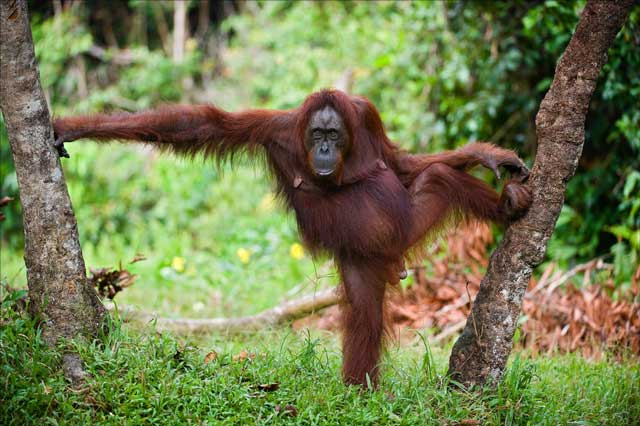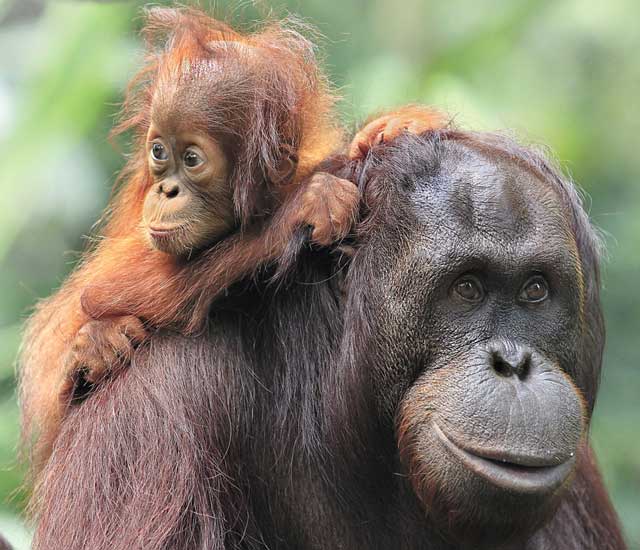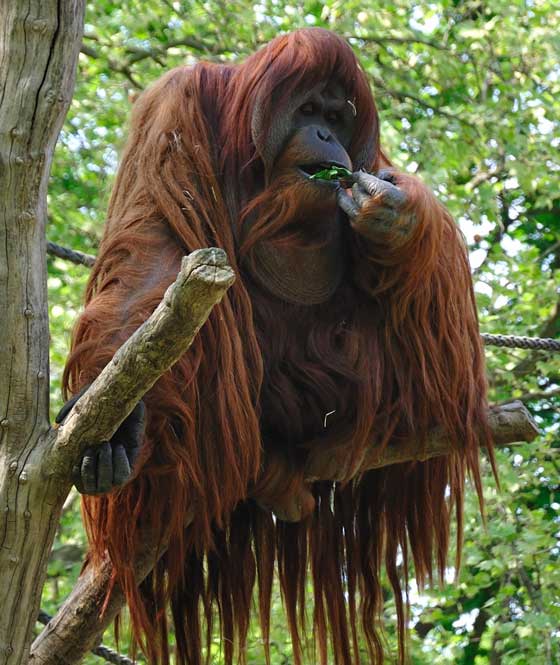|
Some animals, like the orangutan, are so obviously awesome that I never think to do a feature about them. Well, I happened to see a photo of an orangutan the other day, and I decided it's time for this creature to have its day in the spotlight. What the heck is an Orangutan? There are actually three species of orangutans, the Bornean orangutan, the Sumatran orangutan, and the Tapanuli orangutan. They are members of the Great Apes family, called Hominidae. This family, the Hominids, also includes gorillas, chimpanzees, bonobos, and humans. Orangutans currently live only in the rainforests of Sumatra and Bornea in Southeast Asia. Amazing facts about Orangutans First let's figure out exactly where Sumatra and Borneo are. These are two very large islands in Indonesia. Sumatra is the sixth largest island in the world, and Borneo is the third largest island (in case you're wondering, the largest island in the world is Greenland, the second largest is New Guinea). Here's where Sumatra and Borneo are: Orangutans are sexually dimorphic, which means the males and females are very different in ways beyond just their sexual organs. Male orangutans are much larger than females. The males average 165 pounds (75 kg), while the females average only 82 pounds (37 kg). The orangutan is one of the closest relatives to humans—these creatures share about 97% of the same DNA with us. In fact, the word orangutan came from the Malay words orang hutan, which means "human of the forest." Orangutans have longer arms than humans, but shorter legs. A typical male orangutan has an arm span of about 6.6 feet (2 m), which is longer than an orangutan's standing height (about 5 feet). Check out the arms on this male: As you can probably guess from the length of those crazy arms, orangutans spend much of their time climbing in trees. In fact, they spend over 95% of their time in trees. They even make nests of branches and leaves and sleep high in the trees. They eat, sleep, and travel in the rainforest canopy. They travel in the trees? Wouldn't it be easier to just come down to the ground and travel? It would be for you and me, but orangutans are highly skilled at moving through the branches using both their feet and their hands, a process called quadrumanous scrambling. I love that phrase... quadrumanous scrambling. To help them with this quadrumanous scrambling, orangutans have some cool adaptations. First, the muscles and tendons in their hands are arranged so that their hands are in the hooked position when at rest. This allows them to hold on to a branch without expending much effort in keeping their grip. Second, they have long fingers, but the thumb is really short. This gets the thumb out of the way so that their fingers can wrap all the way around a smaller branch and tuck between the branch and the palm, thus locking the grip. Third, their feet have long toes and an opposable thumb, so that they can also grip branches with their feet. Check out this video of climbing orangutans. Notice the size and position of the orangutan's thumb: Orangutans also have extremely flexible shoulder and hip joints, allowing them to hang in almost any position. They can even do cool things like put their feet behind their heads. Orangutans are strong. Most of their strength is in their arms. Here's why. Think about it—human strength is mostly in our lower torso and legs. That's because we are adapted for walking and running long distances. Well, orangutans are adapted for quadrumanous scrambling! They need to travel long distances using their arms (and legs, although in a way that is different from walking). How strong are they? Well, an average, untrained human can leg press about 200% of his/her body weight, which makes our legs about 120% stronger than our arms. But an orangutan's arms are about 300% stronger than its legs. An average orangutan's arms are about 6 times stronger than an average human's arms. I do not recommend challenging an orangutan to an arm wrestling match. I'm not fond of using animals for such spectacles, and the premise of this is ridiculous, but here is a video of a tug-of-war between an orangutan and a sumo wrestler. Orangutans used to live throughout most of Asia, including as far north as China. Deforestation and the spread of humans have caused their range to shrink to only Sumatra and Borneo. Unfortunately, even these islands are rapidly losing their rainforest habitat suitable for orangutans. In Sumatra, there were about 12,000 orangutans in 1993, but now there are only 3,500. In Borneo, there are less than 35,000. That's all that remains of an amazing group of apes. When they're gone, they'll be gone forever. Among the extinct species of orangutan is one with the name of Gigantopithecus blacki. This was the largest ape that ever lived (that we know of). Based on finds that only include jaws and teeth, scientists have concluded that these orangutans weighed as much as 660 pounds (300 kg). Female orangutans are terrific (and patient) parents. They give birth only about once every eight years (they live over thirty years). Why only once per eight years? Because they are usually busy raising the previous offspring. The young orangutan will stay with its mother constantly as she cares for it and teaches it all the necessary skills to survive. This usually takes six to seven years! One of the main skills the mother teaches is how to build a proper sleeping nest, which orangutans do almost every evening. It usually takes three years for the young orangutans to master this skill! As you probably know, orangutans are intelligent, among the most intelligent of nonhuman creatures. Orangutans can learn sign language, and there is even evidence that they quickly learn to make new sounds for vocal communication. They have voluntary control over vocal fold oscillation, an ability that is essential for humans to be able to speak. Orangutans use tools such as sticks to extract insects from tree crevices, and sticks for extracting seeds from fruits. The tools they use vary from one population to another, which means that tool use is cultural. They even use tools in vocal communication. For example, they roll up large leaves and use them like a megaphone to amplify the kiss-squeak sounds they like to make. It is thought that they enjoy doing this because it tricks the listener into thinking they are larger than they really are. I'll wrap this up with a photo of an orangutan with extraordinarily long hair. So, Orangutans deserve a place in the N.A.H.O.F. (Nifty Animal Hall of Fame). FUN FACT: The word nifty originated in the 1800s. It may have started as theatrical slang. It was first seen in print in 1868, in a poem by Bret Harte, who said the word was derived from the word Magnificat (the actual title of the Song of Mary, a traditional song of praise). Nifty is an adjective meaning "very attractive or appealing" (as in, "a nifty new hat for Easter"). Or it can mean "very interesting or clever" (as in, "a nifty idea"). It can also mean "substantial, sizable" (as in, "I sold the car for a nifty profit"). So, nifty is another way to say awesome! Photo Credits:
Orangutan with young #1 - Wanderlust Orangutan arms and legs (photo #2) - Depositphotos Stock Photos Orangutan hand - Depositphotos Stock Photos Orangutan mother with young - Depositphotos Stock Photos Orangutan with long hair - By David Arvidsson - via Wikimedia Commons
0 Comments
Leave a Reply. |
Stan's Cogitations
Everyone needs a creative outlet. That's why I write. Archives
July 2024
|







 RSS Feed
RSS Feed